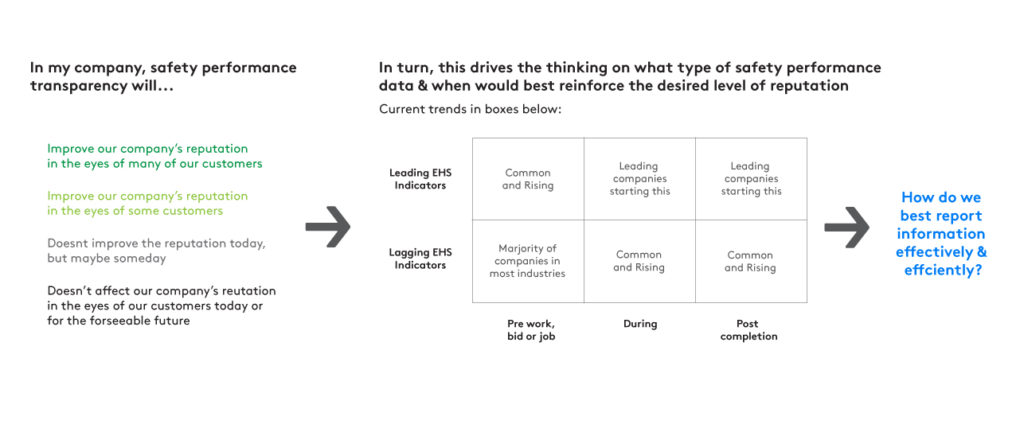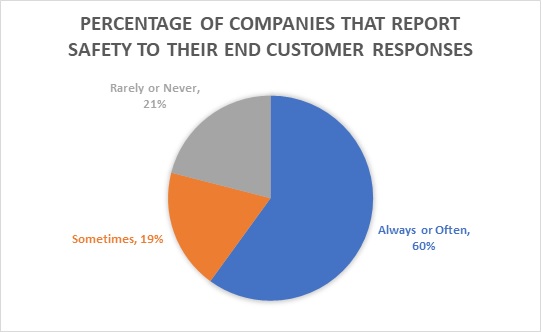Say the words, “reporting to your customer” around most VPs or directors of EHS and get ready for the frowns, the grins, and perhaps the expletives. It’s not that they don’t value transparency. It’s that the whole process of reporting safety performance data to customers is often highly administrative, time-intensive, and even contentious.

In some industries, the rise of contractor registries has pushed attitudes to a breaking point. Across industries, there is a constant battle with the question: How much sharing of information is too much? Will it come back to bite us?
79% of Today’s Companies Report “Something”
When it comes to workplace safety performance, 79% of companies report to their customers in one form or another, and at one point or another. More companies are starting to regularly report safety performance to their customers for the first time. Since 2017, we’ve seen an increasing number of companies move from the “Rarely or Never” category into the “Sometimes” category.
You and your senior leadership team will eventually make a call on whether being a strong safety performer (or a very transparent safety company) will strengthen your reputation in the eyes of your customers or other stakeholders. This decision should be well thought out, deliberate, and communicated across the company.
A Mix of Attitudes Regarding Reporting
I have met owners of companies in the exact same niche who are miles from each other with divergent views on reporting.
Consider these statements from company presidents:
- “Our customers don’t request safety data. We’re just one component in a bigger cog.”
- “Our customers don’t request safety data. But we provide it anyway because it’s who we are. It shows the quality and consistency of our people, process and end-product.”
- “Our customers require historical incident rates when we re-bid on work, but we’re not sure if it drives the decision unless the numbers are way out of whack.”
- “Our customers require historical incident rates. While it may be a small factor in their decision right now, we see this being an increasingly important factor to get right as our industry becomes more competitive.”
These are all actual examples from the same industry. They show the range of attitudes toward sharing safety data with customers and the challenges safety leaders face with successfully handling these situations.
In a world where transparency is increasingly expected and valued, I would argue that it’s better to have the trend as a friend and be proactive with sharing safety performance data with customers.
We all want to know if our chickens are free-range and where the food we consume comes from. So, it’s no surprise business customers want to know if people were hurt in the creation of a product or service.
Choosing the Right Data
The key is to make a subtle paradigm shift: Share safety data in a way that works for your business rather than creating another chore for a customer. This can take different forms, depending on your industry.
The following framework can help your leadership team evaluate what type of safety data you’re sharing now, and how this can evolve, as you answer the basic question, “Is safety linked to our reputation in the eyes of our customer?”
 For project type work, for example, we see an increase in companies sharing leading indicators with their customers. This usually starts before/after jobs are done (depending on the industry) but pushing into real-time sharing of leading indicators throughout the life of a project.
For project type work, for example, we see an increase in companies sharing leading indicators with their customers. This usually starts before/after jobs are done (depending on the industry) but pushing into real-time sharing of leading indicators throughout the life of a project.
One of the big takeaways from this is that leading indicators evolve, and most customers understand this. If you’re looking for some ideas, we’d be happy to put you in touch with others in your industry by reaching out to me via the contact info at the bottom of this article. Or feel free to check out our Definitive Guide on Leading Indicators at http://go.ecompliance.com/White-Paper-Guide-To-Leading-Indicators.html.
Today’s modern methods of sharing EHS performance data can help safety leaders with challenges such as:
- Developing bespoke dashboards of leading and lagging indicators. The only thing more impressive than sending pretty charts and dashboards to your customers is showing them that it is part of a recurring digital process. Why? It shows the plan-do-check-act velocity in your company at its finest and that safety is part of a rigorous process, not just another sales pitch.
But, cutting down on the administration of preparing fancy Excel®/PowerPoint® reports means your solution or technology has to be easily deployed, without dependency on your IT. - Automating frontline data collection. You need high levels of workforce participation to feed these dashboards.
For example, 93% of eCompliance users are frontline staff, capable of reporting opportunities, hazards, controls in place, etc. Their daily data can automatically populate separate dashboards for internal reporting and specialized ones for specific customers.
We all need to continue to innovate safety. Our relationships with our customers are a key economic force and a strong catalyst for behavioral change in our organizations. Use this to your advantage and push it forward.
A strong safety record is a competitive advantage that can instantly set you above your competition. So, shift your thinking. Don’t view reporting your safety data as an onerous task. Think of it as a chance to showcase the great work you’re doing, as well as an opportunity to build even more trust with your customers and would-be customers.
 Adrian Bartha formed eCompliance with his business partner in 2012 after experiencing firsthand how a workplace incident affected a power company that he helped lead. Combining his background in finance with his knowledge of health and safety, Adrian now educates safety professionals on how to demonstrate a return on safety. He shows them how continuous improvement can be leveraged as a competitive advantage, using language that resonates with high-level executives. Adrian Bartha formed eCompliance with his business partner in 2012 after experiencing firsthand how a workplace incident affected a power company that he helped lead. Combining his background in finance with his knowledge of health and safety, Adrian now educates safety professionals on how to demonstrate a return on safety. He shows them how continuous improvement can be leveraged as a competitive advantage, using language that resonates with high-level executives. |

